8 Reasons Why Tomatoes Crack – Understanding and Preventing Fruit Splitting in Tomato Plants

Hey Tomato Lovers!
You adore growing tomatoes in your backyard, right? They’re like the stars of home gardens – versatile, tasty, and oh-so rewarding to grow. But let’s chat about a tricky little problem: those pesky cracks on tomatoes. Why not grab a cup of coffee and join me in unravelling this mystery? Together, we’ll learn what are the 8 Reasons Why Tomatoes Crack and how to keep those tomatoes looking as good as they taste.
Cracking 101: What’s Up with My Tomatoes?
So, there are two ways your tomatoes might crack.
Firstly, we have vertical cracking, characterized by splits that run from the top all the way to the bottom of the fruit. Secondly, there’s concentric cracking, which manifests as circular splits around the top, near the stem.
Now, it doesn’t matter if you’re nurturing those large, juicy beefsteak tomatoes or the delightful heirlooms; these cracks can become gateways for rot, diseases, and annoying pests. Not exactly what you want, right?
So, without further ado, let’s delve into the various reasons that cause tomatoes to crack.
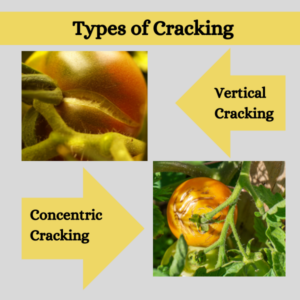
Why Tomatoes Crack: 8 Reasons Why Tomatoes Crack and How to Outsmart Them
1. Inconsistent Watering The Issue
Tomatoes are like Goldilocks – they don’t like it too dry or too wet. Inconsistent watering makes them absorb water too fast, causing their skin to split.
The Fix: Regular watering is key. Aim for a consistent schedule and consider drip irrigation for even moisture.
The Tip: Set a watering schedule and stick to it. Use a rain gauge to measure rainfall and adjust your watering accordingly. Apply a 2-3 inch layer of organic mulch around your tomato plants. It helps maintain soil moisture levels. And finally consider setting up a drip irrigation system for consistent, deep watering.
2. Rapid Growth Spurts The Issue
Sometimes, tomatoes grow too quickly, especially in warm, rainy weather. Their skin just can’t keep up!
The Fix: Keep your plants healthy but not overfed. A balanced fertilizer can prevent overly rapid growth.
The Tip: Excess nitrogen can cause rapid growth and increase cracking. Use a balanced, slow-release fertilizer.
3. Variety Vulnerability The Issue
Some tomatoes are just more prone to cracking. Heirlooms and large varieties often have a tougher time.
The Fix: Choose crack-resistant varieties. Do some research or ask local gardeners for their resilient favourites.
The Tip: Choose crack-resistant tomato varieties such as Sweet Million, Jasper, Matt’s wild cherry, Big Beef, Iron Lady, Roma VF, Juliet, Bush Early Girl, Mountain Merit and Defiant PhR.
4. Extreme Heat The Issue
High heat can lead to quick water uptake, making tomatoes swell and crack.
The Fix: Provide some shade during the hottest part of the day.
The Tip: On scorching days, use shade clothes to protect your plants from the intense afternoon sun. Prune your plants to ensure good air circulation, but don’t overdo it as leaves protect fruits from sunscald.
5. Overripe Fruit The Issue
Leaving tomatoes on the vine too long makes their skin fragile and prone to cracking.
The Fix: Harvest your tomatoes when they’re just right – not too early, not too late.
The Tip: Pick tomatoes when they’re ripe but not overripe. Regularly check your plants for ripe fruits.
6. Nutrient Imbalances The Issue
Lack of calcium can weaken tomato skins, leading to splits.
The Fix: Add calcium to your soil. Eggshells or a calcium supplement can do the trick.
The Tip: Test your soil’s pH and nutrient levels. Adjust with the appropriate fertilizers or amendments.
7. Poor Soil Conditions The Issue
Soil that doesn’t drain well or has uneven moisture levels can contribute to cracking.
The Fix: Work on your soil texture. Adding organic matter can improve drainage and consistency.
The Tip: Ensure good drainage, especially if you have clay-heavy soil; consider using raised beds or containers if necessary. Keep the soil consistently moist but not waterlogged by using mulch to help retain moisture and reduce fluctuations in water levels. Also, maintain soil aeration by avoiding compaction – don’t walk on planting beds and loosen the soil gently as needed.
8. Sudden Heavy Rains The Issue
A downpour after a dry spell can make your tomatoes drink up water too quickly.
The Fix: After heavy rain, check your soil. It might be wet enough without additional watering.
The Tip: Be extra vigilant after a dry spell. If heavy rain is forecasted, give your plants a good drink beforehand to reduce the shock of excess water.
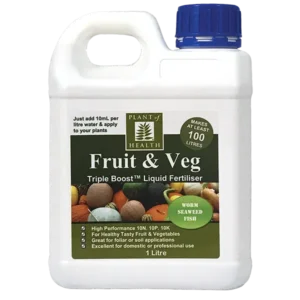
Fruit and Veg Triple Boost Concentrate Liquid Fertiliser 1L
1 reviews $19.90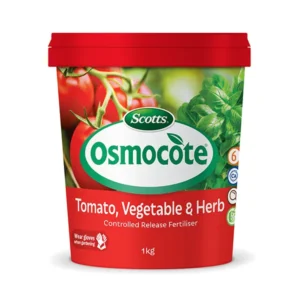
Osmocote Tomato Vegetable & Herb Controlled Release Fertiliser
$9.90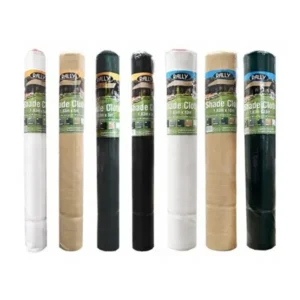
Rally Shade Cloth Pre Pack 5M & 10M
1 reviews $34.90There you have it. With these tips, you’re all set for a beautiful tomato harvest. Remember, a little attention and care can make a world of difference in keeping your tomatoes happy and whole. Happy gardening, and enjoy that coffee!





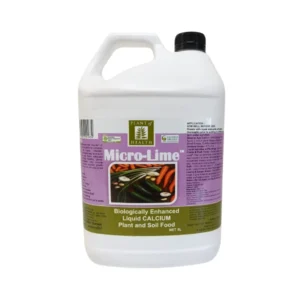
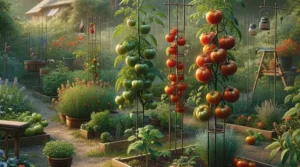
 Mosquito Traps
Mosquito Traps